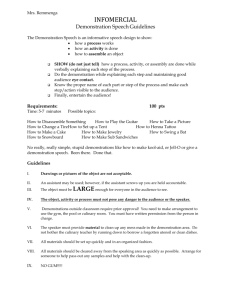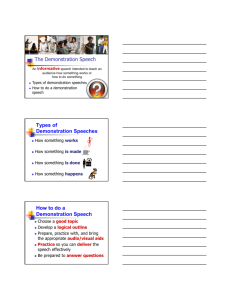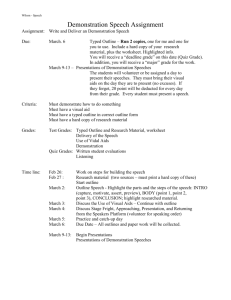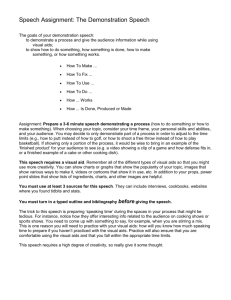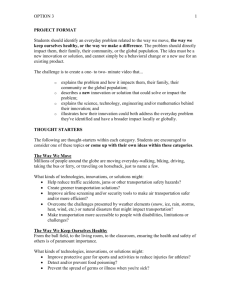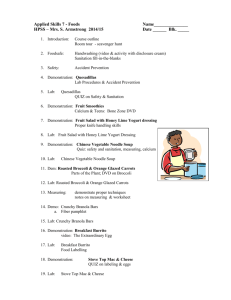Demonstration Speech Guidelines
advertisement
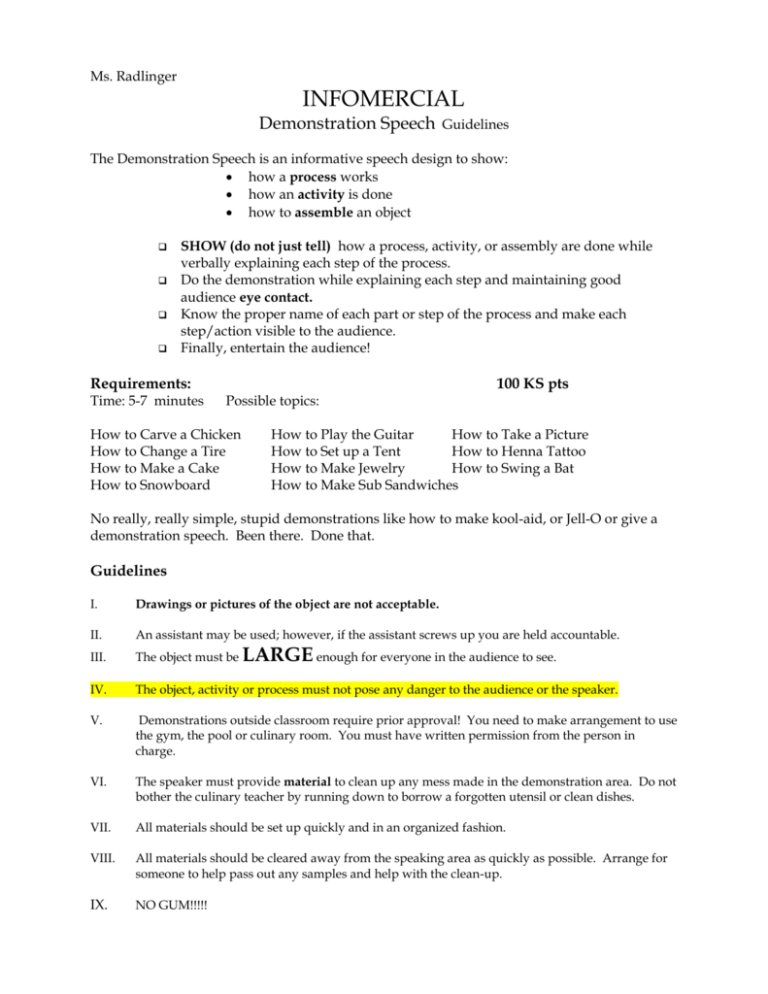
Ms. Radlinger INFOMERCIAL Demonstration Speech Guidelines The Demonstration Speech is an informative speech design to show: how a process works how an activity is done how to assemble an object SHOW (do not just tell) how a process, activity, or assembly are done while verbally explaining each step of the process. Do the demonstration while explaining each step and maintaining good audience eye contact. Know the proper name of each part or step of the process and make each step/action visible to the audience. Finally, entertain the audience! Requirements: Time: 5-7 minutes 100 KS pts Possible topics: How to Carve a Chicken How to Change a Tire How to Make a Cake How to Snowboard How to Play the Guitar How to Take a Picture How to Set up a Tent How to Henna Tattoo How to Make Jewelry How to Swing a Bat How to Make Sub Sandwiches No really, really simple, stupid demonstrations like how to make kool-aid, or Jell-O or give a demonstration speech. Been there. Done that. Guidelines I. Drawings or pictures of the object are not acceptable. II. An assistant may be used; however, if the assistant screws up you are held accountable. III. The object must be IV. The object, activity or process must not pose any danger to the audience or the speaker. V. Demonstrations outside classroom require prior approval! You need to make arrangement to use the gym, the pool or culinary room. You must have written permission from the person in charge. VI. The speaker must provide material to clean up any mess made in the demonstration area. Do not bother the culinary teacher by running down to borrow a forgotten utensil or clean dishes. VII. All materials should be set up quickly and in an organized fashion. VIII. All materials should be cleared away from the speaking area as quickly as possible. Arrange for someone to help pass out any samples and help with the clean-up. IX. NO GUM!!!!! LARGE enough for everyone in the audience to see. CHECKLIST ___Speech Outline TYPE & TURN IN a proper outline before the speech! You may use the body portion of the outline or notecards while presenting. I. Introduction in complete sentences and memorized: A. Attention getter B. Benefit Statement C. Preview Statement (thesis) II. Body of Speech A. List of materials or ingredients needed to conduct procedure. B. List of tools or utensils needed to complete procedure. C. Steps presented clearly and systematically. 1. Arrangement of materials planned out. 2. None of essentials left out. 3. Chronological order. III. Conclusion in complete sentences and memorized A. Closing signal B. Review C. Closing comment INCLUDE AND HIGHLIGHT: ____ 5 transitions - highlighted ____ 5 notations for amplification (i.e. gestures, volume, rate, pause... label them clearly) Visual Aids 1. NEAT and APPEALING. 4. VA displayed only while discussing. 2. LARGE enough for audience to see. 5. Talk to the audience not to visual aid. 3. Displayed where audience can see them. 6. Explain the visual aid clearly. If you borrow any information you must have a Works Cited; however, this information should come directly from you. DO NOT copy an outline off the Internet!!!! Visual Aids PREPARATION 1. Prepare all visual aids neatly and carefully. 2. Make visual aids LARGE. 3. Keep it simple – no clutter. 4. Use striking colors and thick lines. TYPES OF VISUAL AIDS 1. Object 2. Model – scaled down, 3D 3. Map – geographical relationships 4. Chart – diagrams, tables, illustrations. 5. Graph – visual depiction of numerical relationships: line, bar, pie. 6. Chalkboard or Eraser board illustration – write as you speak 7. Transparency or projector 8. Audio recording 9. Video recording PRESENTATION 1. Use pointer if appropriate. 2. Hold the pointer in the hand closest to the chart as you stand facing your audience. 3. Use the pointer to show the elements you are talking about AS you talk about them. 4. Display the chart only as you are talking about it. In other words give your introduction, turn on the overhead give the body portion of the speech and turn off the overhead and give conclusion. 5. Make sure everyone can see the visual aid. 6. Allow enough time for the audience to see the visual aid. Speech Critique Ms. Radlinger Demonstration Speech INTRODUCTION ____ Attention Getter -Type clear? ____ ____ 34 points 6 points Relate topic to audience. Arouse curiosity of the audience. Startle the audience. Question the audience. Begin with an effective quote. Tell a story. Aroused Interest? Purpose/Benefit/Slope Statement clear? 6 points 4 points ____ Thesis - clear _____ Memorized _____ “My speech is about...” 10 points 10 points minus 5 points Body of Speech 10 points each ____ outline typed ____ outline in proper outline format ____ major steps (A,B,C…) ____ list of materials and/or tools ____ 5 amplifications –highlighted (gestures, volume, rate, pause...) ____ 5 transitions - highlighted 60 points Conclusion 34 points _____ Signal the end – “In conclusion…” _____ Review & Reinforce main ideas or steps. _____ Closing Comment- Brought all the points together. _____ Memorized _____ Interesting/clever/creative 6 points 6 points 4 points 10 points 8 points Presentation ___ eye contact 50points ___ posture ___ volume ___ annunciation ___ pacing ____well prepared ____ appropriate object & visual aid ____ samples or audience participation _____ TIME (5-7 minutes) 20 points 10 points 4 points 4 points 4 points 10 points 8 points 10points Total ________/200
